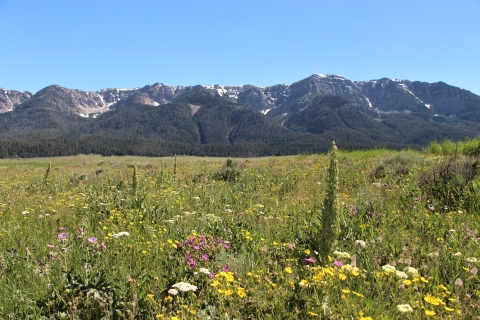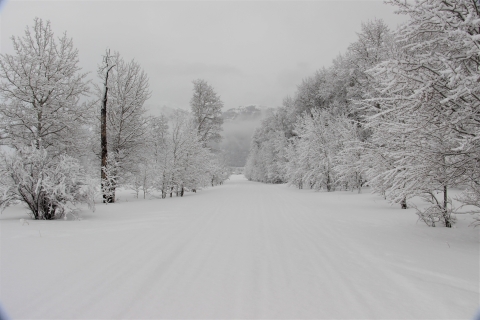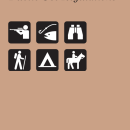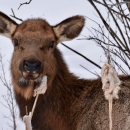Visit Us
Plan Your Visit
Red Rock Lakes National Wildlife Refuge provides wildlife based recreational opportunities to thousands of visitors every year. People enjoy viewing the unique geology and diverse wildlife, whether by canoe, kayak, automobile, or on foot. The Refuge elevation spans from 6,600 feet in the valley to roughly 10,000 feet in the Centennial Mountains, creating diverse habitats and extreme weather conditions. We recommend sturdy footwear, warm clothing, rain gear, a camera, good binoculars and/or spotting scope for optimum enjoyment. Please read this section carefully when planning your visit to increase your enjoyment and safety. Remember, weather is unpredictable on the Refuge; sudden and extreme variations in precipitation and temperature can exist from day to day and week to week.
Best Time to Visit
The best time to visit the Refuge is from May through September. The Refuge receives a lot of snow during the winter months from as early as October extending through April, which makes it exceptionally challenging or impossible to visit. In winter, the only access from the east is via snow machine; traveling from the west is often limited to a 28-mile snowmobile ride from Monida, Montana. May and June will find many birds, and mammals (pronghorn antelope, moose, and elk) giving birth. June and July are best for wildflower viewing. Fall provides opportunity for viewing colorful willows, aspens, chokecherry, and serviceberry (typically the middle-end of September) as they ready for winter.
Weather
Be prepared for cool summer temperatures, frigid winters, and sudden rain or snowstorms during any season. Mosquitoes are abundant from early spring through late summer. Weather in the Refuge is like most places in the Rocky Mountains - it can be warm one day and very cold the next day. Trends are unpredictable. Winter can be as cold as -40F, but it is normally in the sub-teens. It begins to warm up in April and May, reaching daytime temps of 50F to 70F and nighttime temps of 30F to 40F. August can be as warm as 75F-88F with nights at 45 to 50F. Fall begins to become more moderate with daytime temps from 55F to 70F and 25F to 35F during the night. Plan accordingly to ensure you have the proper clothing and footwear.
Roads:
There are few roads through the Refuge - all are rough dirt and gravel roads. The main road is South Valley Road and goes virtually from Monida (I-15, exit 0) through the center of the Refuge and on to US Highway 20 in Idaho (as Red Rock Road), a total of 56 miles. The North Valley Road has numerous sandy areas. Roads may be impassable at any time, but typically during summer the roads are easy to travel for any type of vehicle, albeit rough. Due to sharp obsidian rock and bedrock in some areas of roads that can result in flat tires, travelling over 35 mph is not recommended. Keeping your speed down can significantly help avoid flat tires. Having a good spare tire that is fully inflated is recommended when traveling to the Refuge. A flat tire with no operable spare can lead to a long wait for a passing by vehicle or a long walk to find reception to call a tow truck.
In early spring (April/May) roads may be difficult or impossible to pass due to thawing ground, snowmelt, and spring rains creating very muddy or even flooded conditions. Fill your vehicle's fuel tank up before leaving the paved highways, as it is nearly 50 miles to the nearest gas station - - so plan accordingly. The only area with consistent cell phone coverage in the valley is on the north and northeast side of the valley through Verizon.
Camping and Lodging
The Refuge has a maintained primitive campground (without hookups) at both Upper and Lower Red Rock Lake. Fees are modest: $7 per vehicle per night, $5 with a Federal Interagency Annual, Senior, Access, or Volunteer pass; $4 for each additional vehicle; 16 consecutive day stay limit. Fees are deposited in provided fee envelopes onsite. *Large motorhomes are not recommended in the Upper Lake campground due to mobility issues of turning around.
Be prepared for very chilly/cold weather, especially at night in April, May, and in June and again after August. The only nearby lodging is a very small private resort off the Refuge at Elk Lake that requires advance reservations. There is lodging in Lima, MT (43 miles west) and Island Park, ID (35 miles east). There is potable artesian spring water at the Upper Lake Campground, no water is available at the River Marsh Campground. Trash must be packed out when you leave. Bear food storage requirements are in effect, and both Upper Lake and the River Marsh Campground have bear-safe food storage containers available.
Food
There are no commercial places at the Refuge to buy food (prepared or otherwise), except near Elk Lake (and only by reservation, if available). Plan to bring enough food and water for the length of your stay. A trip to the nearest store may be 100 miles or more round-trip. Spring water is available at Upper Red Rock Lake campground and there is a drinking fountain at the visitor's center. There are no vending machines in the valley.
Restrooms
Each campground has a primitive toilet. The visitor center has a primitive toilet outside for use when the center is closed and an indoor restroom with water when open. Please DO NOT put anything other than toilet paper in the toilets.
Medical Facilities
There are no medical facilities within at least 55 miles of the Refuge, and those are not easy to reach quickly from the primitive Refuge roads. If you visit the Refuge and suffer from a chronic medical condition, bring the appropriate medications and supplies, as it will be difficult or impossible to obtain them here in a timely manner. Also note that the altitude could adversely affect existing cardiac or breathing conditions if you are not acclimated to 6700 feet.
Please dial 911 if you have a medical emergency. NOTE: Cell phone coverage is not available in all places throughout the Refuge - only partial coverage through Verizon on the far north side or eastern end of the valley. If the visitor center is open there is a landline available for emergency use. Due to the long distance over rough terrain to the nearest hospital with an ER, the rough ride for a patient could be potentially dangerous, so any medical emergency usually results in the dispatch of air medical flight services, when weather and wind conditions allow.
Exploring
You will find opportunities to hike, fish, hunt, take pictures, and observe a variety of wildlife and wildflowers at the Refuge. While visiting the Refuge, feel free to stop by the visitor's center and headquarters in Lakeview, Montana for information.
Wildlife observation, hiking, and photography are permitted on the Refuge, except in areas designated as closed to public entry. The area around Shambow Pond is closed to the public year-round, except for pictures from the road. There are also some other small areas with seasonal closures to protect wildlife. To capture the wilderness explorer spirit, there are two hiking trails - Odell Creek Trail and Sparrow Ponds Trail.
For an up-to-date report on the road conditions on area roads outside of Red Rock Lakes National Wildlife Refuge, view the Montana Department of Transportation website. Montana Department of Transportation also has a camera at Monida Pass on I-15 near the turn-off to Red Rock Lakes National Wildlife Refuge to show real time conditions. For Refuge road reports, please contact the Refuge at (406) 276-3536.
Activities
Activities on the Refuge range from wildlife photography, camping at one of two designated campgrounds (River Marsh Campground at Lower Red Rock Lake and Upper Lake Campground at Upper Red Rock Lake), hunting permitted species in season in designated areas, fishing in designated areas, landscape and wildlife photography, hiking Sparrow Pond Trail or Odell Creek Trail, and bird/wildlife watching.
Trails
The Refuge offers two easy rated out and back trails - Sparrow Pond Trail and Odell Creek Trail. Both trails offer their own unique experience ranging from wildlife watching to scenic landscape views.
Be Bear Aware
Grizzly bears are present on all areas of the Refuge to include, but not limited to: forest, willows, sagebrush sagebrush
The western United States’ sagebrush country encompasses over 175 million acres of public and private lands. The sagebrush landscape provides many benefits to our rural economies and communities, and it serves as crucial habitat for a diversity of wildlife, including the iconic greater sage-grouse and over 350 other species.
Learn more about sagebrush -steppe, grasslands, wetlands, lakeshores, and creeks. The carrying of bear spray on your person where it is readily accessible is strongly recommended.
Related Documents
Other Facilities in the Complex
Red Rock Lakes National Wildlife Refuge is part of the Centennial-Jackson Valleys National Wildlife Refuge Complex, which also includes the National Elk Refuge in Jackson, WY.
Rules and Policies
Vehicles (cars, trucks, etc.):
· Motorized vehicles are prohibited on Refuge lands except on designated public roads and Refuge roads open to travel.
· Off-road travel, to include dirt two-tracks, except that portion of Culver Road when open, is prohibited on the Refuge.
· Travel on closed roads or going around gates is illegal.
Pets:
· All pets must be leashed. Hunting dogs being used during the appropriate waterfowl hunting seasons must be under the owner’s immediate control at all times.
Campfires:
· Fires are allowed only in the fire rings provided in the Upper Lake and River Marsh campgrounds. Fires are not allowed in/on any other areas of the Refuge.
· The Refuge reserves the right to prohibit all fires in campgrounds pursuant to weather conditions.
Collecting:
· All government property, including natural, historic, and archaeological features, are protected by Federal law.
· Searching for or removal of objects of antiquity, plants, animals, animal nests, rocks, antlers, bones, skulls, or other objects is prohibited.
· Please also do not pick flowers or other vegetation so that future visitors will enjoy them as you have. Picking berries and mushrooms is also prohibited.
· Cutting, removing, or damaging any tree or other vegetation, standing or down, live or dead is prohibited.
Prohibited Activities:
· Possession or use of fireworks or explosives is not permitted on the Refuge.
· Swimming is not allowed in any body of water on the Refuge.
· Drones are not permitted for use on the Refuge
· Geocaching is not allowed on the Refuge.
Activities not described in this section OR the activities section(s) are prohibited on the Refuge. To inquire about regulations or Refuge operations, contact the Refuge staff at: 406-276-3536
Locations













The Refuge is located in a high elevation mountain valley with the east-west running Centennial Mountains providing the southern border. Winters are long and cold with summers being short and mild. In short, the Centennial Valley is an undeveloped valley where nature is still in control and ruggedness prevails.
Special Facts
Red Rock Lakes National Wildlife Refuge is located in the middle of an important wildlife corridor wildlife corridor
To maintain healthy species populations and ecosystems, fish and wildlife need the freedom to move and migrate. As habitats and migration routes are affected by climate change and fragmented by roads, fences, energy development and other man-made barriers, wildlife struggle to reach necessary areas to feed, breed and find shelter. A wildlife corridor is a piece of undeveloped land connecting two habitats so wildlife can move safely between them.
Learn more about wildlife corridor linking the Greater Yellowstone and the High Divide ecosystems. More specifically, the Refuge:
- Protects over 83,000 acres of the Centennial Valley in southwest Montana—the least developed valley of its size in the state
- Encompasses the largest wetland complex in the Greater Yellowstone ecosystem
- Contains 3,300 acres of sandhills habitat—a place that contains several regionally rare plants and invertebrates
- Represents one of the most diverse Refuges in the contiguous United States, with 45 identified vegetation associations
- Played an integral role in the continental restoration of trumpeter swans
- Continues to provide critical nesting habitat for a tri-state flock of trumpeter swans
- Supports a large portion of the last native population of Arctic grayling in the contiguous United States
- Provides habitat for one of the highest-density wintering moose populations in Montana
- Is in an area that has a rich paleohistory as a gathering spot for people and wildlife throughout time
- Occurs in an area of early non-native exploration and settlement, and has historic buildings originally constructed by the Works Progress Administration
- Has broad range of partnerships that are integral to every aspect of refuge management, including hunting, fishing, and research
- Provides visitors with a multitude of wildlife-dependent recreational opportunities in a remote, peaceful, beautiful setting
- Encompasses a 32,500-acre designated wilderness area wilderness area
Wilderness areas are places untamed by humans. The Wilderness Act of 1964 allows Congress to designate wilderness areas for protection to ensure that America's pristine wild lands will not disappear. Wilderness areas can be part of national wildlife refuges, national parks, national forests or public lands managed by the Bureau of Land Management.
Learn more about wilderness area
Directions
Red Rock Lakes Refuge can be reached from the west on Interstate 15 in Montana (turn at the Monida Exit 0 off-ramp towards South Valley Road). From the east, take US 20 in Idaho and exit at the Red Rock Road and follow the signs west to the Refuge. The distance to the Refuge Headquarters is about 28 miles from either direction. The road is a wide dirt and gravel road maintained only from about May through October. Access is limited or impossible due to snow after these dates. Careful consideration should also be taken if it has been rainy. Large motorhomes are not recommended due to rough road conditions in some places.








